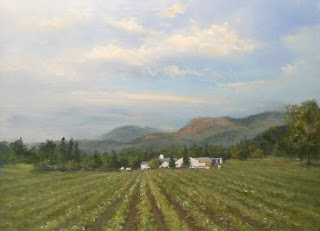The Napa Valley is located northeast of San Francisco and is considered
to be one of the top Viticultural (wine growing) regions in the United States.
 |
| Napa Valley Winery, 9x12, oil |
The early settlers primarily
raised cattle, grain and fruit crops. By the late 1800’s there
were more than 140 wineries in the area. Several of the original wineries are
still in operation.
With the great silver rush in
1858 miners flocked to the region. While gold was being prospected in other
areas of the state, Napa County became a center for silver and quicksilver mining.
Viticulture in the Napa Valley suffered a setback with Prohibition in 1920, compounded by an insect infestation which
killed many of the vines throughout the valley. These two events caused many
wineries to shut down and stalled the growth of the wine industry for years. But for some farmers, Prohibition offered a unique
opportunity for growing and shipping grapes to home winemakers across the country. When
Prohibition ended in 1933, this new industry suffered when the price of grapes fell to below $24 per ton. Thankfully during these years the resourceful farmers had planted over 500,000 fruit and nut trees in the valley and this helped to soften the blows to the agricultural
economy.
The years following WWII saw a growth in businesses related to
agriculture, cattle and tourism with wine grapes again becoming the primary
focus. Today the Napa Valley is home to over four hundred
wineries and is visited by approximately five million people each year.
I always enjoy reading a bit about our destinations. It's a fascinating world. I wonder where artist, Bill Guffy, will send us in July? Only two more days to wait! Join us, new members are always welcome.
Thanks for visiting,
No comments:
Post a Comment
Your comments and questions are always welcome. Thank you.